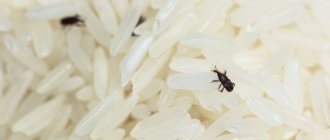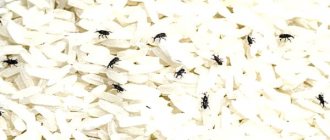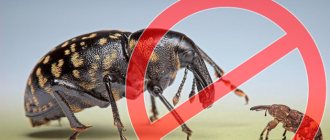Where do insects come from?
Pests can settle in bulk products for three reasons.
- Uncleanliness of the housewife. Unsanitary conditions in the kitchen are the least likely cause of “uninvited guests.” Even if you do general cleaning every day, you cannot be guaranteed to protect yourself from pests: insects can be brought into the house along with purchases from the store.
- Dishonesty of suppliers. Factories do not always comply with sanitary control requirements: storage conditions are often violated, and products do not undergo the necessary heat treatment. As a result, the housewife buys cereals that already contain pests.
- "Dangerous neighborhood." Insects can “immigrate” into cereals from nearby stocks of tea, herbs, pasta, dried fruits, and seasonings purchased by weight.
What are these pests and how dangerous are they?
Let's get to know pests better and find out which bugs most often “settle” in dry cereals.
Small flour beetles
Reddish-brown long bugs (3-3.5 mm) with wings, short antennae and rounded sides. Pests like buckwheat, semolina, flour, dried fruits, and millet. Flour bugs need to be dealt with immediately: eating foods with insects can cause stomach disorders, poisoning, and allergic reactions.
Small beetles reproduce at an astonishing rate: pests produce up to four generations of offspring per year. Mealworms are the larvae of this pest.
Surinamese mucoeds
Red beetles with long mustaches, whose body has a saw-tooth shape and is lined with short silky hairs. The length of insects is 1.5-2.5 mm. Typically, mealworms find refuge in rotten flour, corn grits, and loose pet food. Bulk products with a moisture content of less than 15-17% are not afraid of such pests.
One of the characteristic signs of “infestation” with red pests is a sieve for sifting flour chewed to holes. Con, insects increase the humidity of the cereals, littering the reserves with excrement and shells of larvae.
Bread grinders
Brown or red-brown bugs are cylindrical in shape, 1.8-3.7 mm long, the body of which is covered with hairs. Pests are unpretentious when it comes to food. Cereals and grains, tea and coffee, dried herbs, crackers, cookies, pet food, nuts and dried fruits - voracious insects are not averse to eating all of this.
The waste products of grinders are hazardous to health. Even if you manage to remove the insects from their grains, eating the spoiled product is strictly contraindicated.
If the number of insects is small, you may not even notice their presence - they do not crawl out. But if the density of their “population” is high, waste products and dead insects are found in herbariums, book bindings, even on walls and window sills.
Rice weevils (elephants)
Dark brown or almost black beetles with underdeveloped wings, body length - up to 4 mm. Most often, the pest settles in pasta, rice, barley grains, millet and rye, and flour. The waste products of pests and larvae are toxic, therefore, if even one beetle is found in the products, they can no longer be eaten.
food moth
A gray moth, the body length can reach 1 cm. The moth part is found in dried herbs, cereals, sugar and flour. Food moths, feeding on food supplies, contaminate them with excrement and remains of shells.
When asked whether bugs in cereals are dangerous for humans, experts answer in the affirmative, so if insects are detected, you must immediately begin fighting them.
What to do with contaminated products?
If there are bugs in flour or cereals, they need to be removed as quickly as possible, since they will colonize all the reserves in a short period of time. In the case when most of the products are contaminated, there is a temptation to process them and eat them. However, you should think about it, because insects secrete special enzymes and waste products that can cause the development of allergic reactions.
With severe infection, poisoning occurs. There is another danger. When insects infect flour, they lay eggs, from which larvae emerge.
Small pests feed on the bulk product, so its nutritional value is significantly reduced. In addition, worms almost always evoke feelings of disgust and disgust.
How to get rid of bugs in cereals
It is worth removing beetles from cereals only if there are few insects. If pests have abundantly colonized bulk products, no traditional methods will help. Insects lay eggs in cereals, which are almost impossible to notice with the naked eye. There may also be colorless bugs - larvae - in the reserves.
However, even the elimination of contaminated food, judging by reviews, does not always guarantee freedom from unpleasant “neighbors.” But you can try by performing three consecutive steps.
- Screening. Armed with a sieve, sift the flour and carefully sort the cereal.
- Calcination. Calcine the product in an oven preheated to 100-110°C.
- Washing. Immediately before use, soak the cereal in a salt solution, then rinse thoroughly in running water.
There is only one way to effectively get rid of insects in cereals: throw away all products in which insects are found and carry out a thorough disinfestation.
Let's sum it up
The flour beetle (or beetle) is a pest that feeds on flour, cereals and other products. It leaves behind excrement and chitin after molting, which can cause allergies. The insect can also carry an infection.
To get rid of the parasite, contaminated products are sifted, heated or frozen. In extreme cases, insecticide treatment is carried out. For prevention purposes, cracks in the room through which the beetle can enter are sealed. Substances that repel it are also placed there: steel, garlic, lavender, vinegar.
How to prevent uninvited “guests” from multiplying
Even if the parasites thrown out along with the cereals never return to the kitchen, some of the insects, having spread throughout the house, will continue to reproduce successfully. To completely eliminate pests, you need to act in three stages.
Inspection of stocks and sending to quarantine
Carefully check all food stored in the house for the presence of voracious insects. Throw away all supplies containing pests. Place cereals in which no traces of pests were found in the freezer for three to four days. After this period, you should carefully sort through the bulk products: if the bugs do not appear, they can be placed in jars for storage.
Washing containers
If cereals attacked by insects were stored in plastic or glass containers, the containers can be disinfected. At home, this can be done like this: soak for half an hour or longer in a strong soap solution, then rinse with running water and dry. It is best to replace the storage jars with new ones, after washing them with soda or laundry soap.
spring-cleaning
You can treat the cabinets to get rid of bugs in the cereal with a strong solution of laundry soap and soda. It wouldn’t hurt to wipe down the shelves, tables, window sills, floors, even the walls in the kitchen. After this, walk over the surfaces with a cloth moistened with a 9% vinegar solution (a tablespoon per liter of water). Pour boiling water over latches in cabinets, cracks in floors and walls.
It is advisable to clean the cabinets with a vacuum cleaner using a narrow attachment: this measure will help get rid of eggs, larvae and pest excrement. Particular attention should be paid to corners, cracks and doors.
Habitats of the flour beetle
Small Khrushchak prefers to live in warehouses, granaries, pasta factories, but is also found in apartments. Females penetrate into the smallest cracks in boxes, bags or bags of food and even into cracks in walls, breeding under wallpaper. Plastic, paper or fabric are chewed by harmful insects. Due to the fact that the eggs are covered with sticky mucus, they stick firmly to any surface.
For housing, they choose pantries, kitchen drawers (scattered cereal), and places where there is a lot of dust, such as baseboards. This does not mean that pests sit quietly in the products and do not crawl out anywhere; if their numbers are large, they feel like full-fledged masters in the apartment and crawl anywhere, only smooth vertical surfaces are beyond their power. For tormentors, damp, stale foods are preferred, and if there are such places in the house, perhaps you store pasta or cereal on the balcony, in a closet where there is no ventilation, most likely the place where bugs spread is located there.
The large beetle needs high humidity to develop, while the small one lives happily in dry apartments with heating.
Prevention: 6 rules of defense
The best remedy for bugs is prevention. By following six rules, you can protect your supplies from voracious pests.
- Use the “correct” storage containers. To prevent bugs from infesting cereals, you need to store cereals in tightly sealed glass jars or plastic containers.
- Process purchased products. Before storing cereals after purchase, they should be heated for 15 minutes in a preheated oven. This applies even to those bulk products that are packaged in vacuum bags. Another option is to put the cereal in the freezer for several days. These methods will help destroy the bugs in the cereal and prevent them from spreading throughout the house.
- Place garlic cloves or bay leaves in containers with cereals. A bay leaf or two or three garlic cloves in each jar of bulk products will help protect cereals from bugs. Fragrant “repellents” can also be placed on the shelves of kitchen cabinets.
- Store nuts and dried fruits in the refrigerator. Often, along with these products, especially those purchased in bulk, pests “arrive” in the house, so it is worth placing healthy goodies in the refrigerator.
- Don't turn your kitchen into a warehouse. A modern housewife can buy everything she needs at any time: there is no shortage of cereals in the near future. The fewer products are stored in cabinets, the less likely they are to become “infested” with insects, and the easier it is to get rid of pests if parasites do show up. Ideally, cereals should not be stored for more than two to four months.
- Maintain cleanliness. Regularly clean kitchen cabinets and cereal storage containers with a solution of 9% vinegar at least once or twice a month. If pests appear in the kitchen again and again, you should seek help from specialized organizations.
When thinking about how to remove bugs from cereals, you need to remember that eating foods that once contained insects is dangerous to health: eggs and larvae of pests can simply not be noticed. It is best to get rid of such stocks.
Video on the topic
Where do the bugs hide?
Parasites live in secluded places in the kitchen, and not only in grain crops. Preparing a folk remedy for poisoning is not the wisest decision. This is due to the persistence of parasites in the most unexpected places. Here are some examples:
- spices and medicines. Favorite medium: mustard plasters, pepper, seasoning, various herbs. Carefully inspect the drawers and boxes where spices are stored. Check the packages of patches, tablets;
- coffee beans, loose leaf tea, dried fruits. Mucoeds and rice weevils are not visible in a filled dark container due to their camouflage color;
- boxes with vegetables. Living creatures prefer to spoil and feast on the bulbs. Vegetables become soft and smell unpleasant. Go through the box or grid. If you find a creeping buildup, discard immediately;
- walls of kitchen cabinets, cracks, window sills, floors. The light is not pleasant to the winged ones, so they hide in secluded places;
- Appliances. Small creatures nest in mixers and meat grinders, where food particles remain.
We suggest you familiarize yourself with How to disinfect an acrylic bathtub
Beans remain the perfect home for unpleasant inhabitants. By gnawing holes in beans, they lay eggs there. The beans become covered with dark spots and holes. Throw away such beans without regret.
Expert opinion
Tatiana Leontyeva
Professional housewife
I recommend storing your homegrown beans in the refrigerator. Agree that it is unpleasant to cook a dish from beans that have previously been attacked. But they must be consumed quickly after this.











